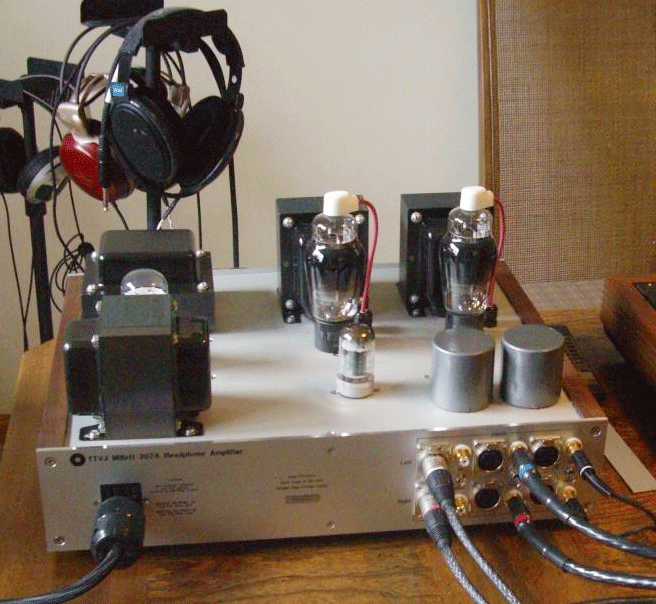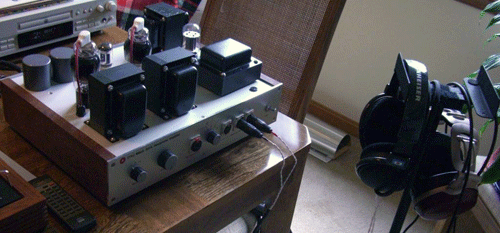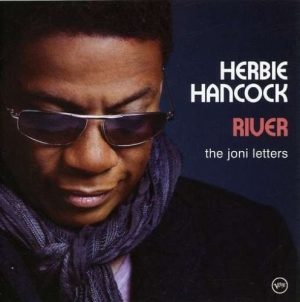The TTVJ Millett 307A Headphone Amplifier
| The TTVJ Millett 307A Headphone Amplifier |
| Deluxe Headphoning |
|
|
|
May 2009 |

For headphone enthusiasts the spectrum of old and new solo listening opportunities is broader and more interesting than ever. Personal experiences with such activities are almost ancient. This goes back several decades to my pre-teen years when I constructed a crystal set radio and enjoyed fascinating AM broadcasts during the 1950s over very primitive cans. Gradually, new gear and more exotic earphones entered my world and the range of things from makers such as Koss, Grado, Sennheiser, Yamaha, Stax and many others helped to enhance that style of more serious solitary listening. While having amassed a fairly wide collection of more sophisticated headphones over the past five years, I typically do more listening through my main loudspeaker-based system rather than by cans. Still, there are situations and circumstances when only headphones will serve, and for those occasions there is much to enjoy.
My current in-home collection includes six different headphones and three headphone amplifiers. Sources include both CD gear and analog playback, and as this review unfolds these items will be identified. [For the moment I won’t discuss my portable stuff based around an iPod, a Ray Samuels SR-71 amp and either Etymotics ER-4 buds or a Stax SR-001 mobile system.]
The focus for this report is the TTVJ Millett 307A Headphone Amplifier, which is a marvelous, exotic and expensive tube offering from Todd Green, the man behind the retail operation in Montana known as Todd the Vinyl Junkie. In collaboration with the well-respected audio designer Pete Millett, the 307A amp was produced and it is in the stratospheric realm of single-ended vacuum tube devices available for headphones these days. The circuit is designed around a pair of 307A pentode tubes [used as triodes], and includes expensive custom wound transformers, along with many other intriguing elements. This unit is skillfully hand assembled by Millett himself in Texas and it manifests as one hefty, industrial looking, serious $6000 component.
Features include three sets of both balanced and unbalanced inputsplus dedicated balanced and unbalanced outputs. These allow for a truly encompassing diversity of sources and headphones. Uniquely, a rotary switch is right up front for accommodating specific impedance requirements, and that is quite useful. Everything related to operational activities happens easily. There is a strong sense of confidence about the build quality, durability and sonic performance, which should make any fortunate buyer feel elated about owning this amplifier. If you read no further you should know that this is indeed a special product, but hopefully the following story might be useful for most serious headphone fans.
The evaluation process employed two main signal sources, a Naim CD2 player and my trusty Linn Sondek LP12 turntable. The analog rig included a Naim ARO tonearm, an EMT Jubilee JSD6 cartridge and an Audio Research PH3SE phono stage. Ancillary interconnects and power cords from Cardas, Zu and ARC were employed. Early in the process an alternative CD player [an older Fostex Pro CDR player/burner] was utilized for some of the preliminary evaluation, however, it was eventually deleted since the Naim CD2 was the superior performer.

The array of headphones included both unbalanced and balanced offerings, some of which were on loan from Todd Green [e.g., the Grado and AKG701 sets], and that will be denoted in the text. Here is the line-up:
* AKG K1000
* AKG 701 Balanced [from TTVJ]
* Audio Technica W1000
* Audio Technica L3000
* Grado GS1000 Balanced [also from TTVJ]
* Sennheiser HD600 with Equinox cabling [Todd also lent a swap-out Equinox Balanced cable for this review]
* Sony MDR SA5000
*Ultrasone Edition 9
 All of the headphones were far beyond any break-in periods, as was the 307A amplifier. Normal headphone amplification options in my home include a Yamamoto Sound Craft HA-02, a PS Audio GCHA and the Meier Audio Corda Head Five, with the tubed Yammy HA-02 seeing most of the action during normal listening. A wide range of music was auditioned during this evaluation process including silver and black discs of standard jazz, classic rock and full orchestral material from both audiophile labels and ordinary commercial makers. Solo piano, choruses, pipe organs and even wacky, experimental avant garde goodies got a fair share of ear time as well. A partial list of the discs most heavily used includes: Court and Spark by Joni Mitchell [LP and CD], Kind of Blue by Miles Davis [LP and CD], Waltz for Debbie by Bill Evans [LP], River: The Joni Letters by Herbie Hancock [CD], Crime of the Century by Supertramp [LP], Nojima Plays Liszt by Minoru Nojima [LP], Pomps and Pipes by the Dallas Wind Symphony [CD], Road by the Paul Winter Consort [LP and CD], If I Could Only Remember My Name by David Crosby [LP and CD], Testament by the Turtle Creek Chorale [LP and CD], and Britten’s Noyes Fludde by Norman Delmar [LP].
All of the headphones were far beyond any break-in periods, as was the 307A amplifier. Normal headphone amplification options in my home include a Yamamoto Sound Craft HA-02, a PS Audio GCHA and the Meier Audio Corda Head Five, with the tubed Yammy HA-02 seeing most of the action during normal listening. A wide range of music was auditioned during this evaluation process including silver and black discs of standard jazz, classic rock and full orchestral material from both audiophile labels and ordinary commercial makers. Solo piano, choruses, pipe organs and even wacky, experimental avant garde goodies got a fair share of ear time as well. A partial list of the discs most heavily used includes: Court and Spark by Joni Mitchell [LP and CD], Kind of Blue by Miles Davis [LP and CD], Waltz for Debbie by Bill Evans [LP], River: The Joni Letters by Herbie Hancock [CD], Crime of the Century by Supertramp [LP], Nojima Plays Liszt by Minoru Nojima [LP], Pomps and Pipes by the Dallas Wind Symphony [CD], Road by the Paul Winter Consort [LP and CD], If I Could Only Remember My Name by David Crosby [LP and CD], Testament by the Turtle Creek Chorale [LP and CD], and Britten’s Noyes Fludde by Norman Delmar [LP].
BULLETS:
Let’s get the broad generalities out of the way fast.
*Yes, the TTVJ 307A is a top flight sonic, real-world performer, leaving most things in the dust.
*Yes, listening in the balanced output format is superior in every way.
*Yes, those in the know who own very fine headphones need to audition and seriously consider this amplifier.
The first generality is not a frivolous statement and I am happy to note that I’ve had good experiences listening to much of the exotica out there, if not at shows, then in domestic settings, usually for more than a few minutes at a time. This does include the Sennheiser Orpheus system, which has a special place in my heart and mind, as I know it does for others world wide.
Regarding some specific observations, there is no question that analog playback through this amplifier is the big winner. It’s not that the Naim CDP is chopped liver, but the energy and pace issues that came through on CDs did not satisfy in the same way that the entire presentation felt with vinyl. The biggest differences included the intrinsic sense of ease and naturalness coupled to harmonic integrity and soundstage/space portrayed by the analog format. The 307A allowed those characteristics to be very obvious and one would and should expect that from a world class amplifier. It is not easy to describe the sonic signature of Todd’s amp primarily since it appears to be a neutral tool handily and competently passing along everything else in the audio chain. This became clear to me when I made direct comparisons to my own home fav, the Yamamoto HA-02 amp. That simpler, but lovingly made unit is nowhere near as neutral as the 307A, primarily bringing added warmth and romanticism to the listening table. This is not done in a destructive or annoying manner, but the forgiving nature of the Japanese product does not let everything through with the same resolution, articulation, agility, beauty and seductiveness of the TTVJ amp. Considering the five-fold difference in price between amps I continue to hold the Yammy in high regard and am happy to be an owner.
I do have comments on how the different headphones fared in combination with the 307A, so let’s get into that now. [By the way, unless otherwise specified, most of the phones were used in unbalanced configuration.]
![]()
Don’t forget to bookmark us! (CTRL-SHFT-D)
Stereo Times Masthead
Publisher/Founder
Clement Perry
Editor
Dave Thomas
Senior Editors
Frank Alles, Mike Girardi, Russell Lichter, Terry London, Moreno Mitchell, Paul Szabady, Bill Wells, Mike Wright, and Stephen Yan,
Current Contributors
David Abramson, Tim Barrall, Dave Allison, Ron Cook, Lewis Dardick, John Hoffman, Dan Secula, Don Shaulis, Greg Simmons, Eric Teh, Greg Voth, Richard Willie, Ed Van Winkle, Rob Dockery, Richard Doron, and Daveed Turek
Site Management Clement Perry
Ad Designer: Martin Perry







Be the first to comment on: The TTVJ Millett 307A Headphone Amplifier